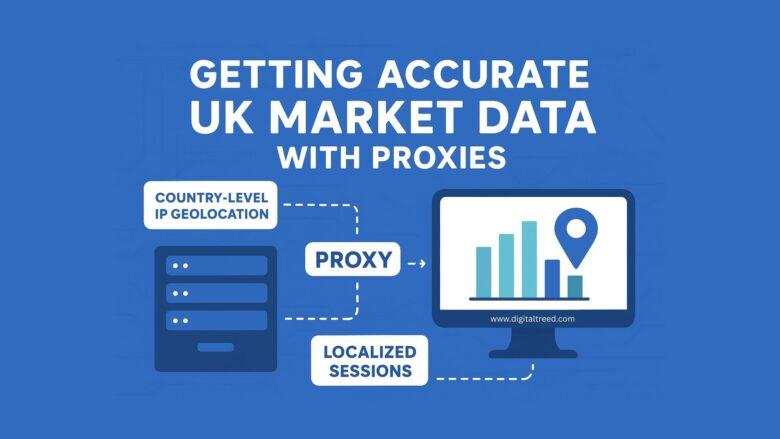Getting UK market data wrong is rarely a matter of code alone. Location, network physics, and anti-bot controls decide what you see and how fast you see it. If you collect at scale, the safest path is to align your pipeline with measurable realities rather than assumptions.
What the numbers say about location and access
Country-level IP geolocation from leading commercial datasets is above 99 percent accurate. That means a site can confidently treat you as being in or out of the United Kingdom based on your exit IP alone. If your crawler exits elsewhere, you will often receive different catalogs, prices, shipping rules, or even full blocking pages.
Network latency compounds the problem. A typical transatlantic round trip sits around 70 to 100 ms. Modern pages are not single fetches; the median page issues roughly 70 requests and transfers about 2 MB of data. Even with parallel connections, extra tens of milliseconds on each dependent fetch stack into more timeouts and more partial renders when you rely on client-side JavaScript to build the page.
Finally, assume you are not alone. Industry analyses regularly show that automated traffic makes up a large share of total requests, with malicious automation representing a significant fraction on many monitored properties. That footprint explains why defenses key off simple signals like ASN, geolocation, TLS and HTTP fingerprints, header regularity, and session stability.
- Country-level IP geolocation accuracy: 99 percent+
- Median page complexity: about 70 requests and ~2 MB transferred
- Transatlantic RTT budget: roughly 70 to 100 ms per round trip
- Automated traffic share: a large portion of all web requests on many sites
Where a UK exit IP is non-negotiable
If your brief includes VAT-inclusive pricing capture, regional promotions, retailer availability by UK postcode, delivery fees, or compliance banners specific to UK law, a non-UK exit will skew the dataset. Retailers routinely adjust price and stock visibility by country. Shipping matrices also pivot on UK-specific carriers and zones. Financial services, ticketing, gambling, and media frequently gate content at country level, and consent managers often show different flows to UK users.
For these cases, route collection through a UK-resident pool and keep everything else consistent with local user behavior. If you need a plug-and-play option, use a provider that lets you change IP to the UK with session controls, predictable concurrency, and transparent ASN mix.
Operational choices that move success rates
Stable sessions beat raw rotation. Rotation on every request looks artificial and often trips risk engines that expect repeat views within a session. Prefer session lifetimes that last several minutes or a handful of pageviews, and reuse TCP/TLS connections to amortize handshake costs.
Headers matter. Serving en-GB in Accept-Language, a UK timezone, and a realistic user agent reduces edge-case experiences. JavaScript rendering should mirror the site’s expectations; many modern sites require a full browser. Where a page is built via XHR calls, intercept and reuse the same cookies, headers, and timing.
Use UK-exit IPs with country accuracy above 99 percent for location-sensitive targets
Configure sessions to persist for multiple requests rather than rotating on every hit
Adopt en-GB Accept-Language and UK timezone for consistent content variants
Throttle by origin: keep request pacing human-realistic to avoid concurrency spikes
Render with a real browser where the DOM is built client-side; cache static assets to cut repeat latency
Store and replay consent and cookie flows so subsequent views skip banners
Measure what matters, not just HTTP 200s
Success rate alone can mislead if you are landing on fallback experiences. Track distribution of 200 vs 403/429, but also validate whether the DOM contains the expected product elements. Monitor median and p95 time to first byte and full render time; cross-check these when you switch between non-UK and UK exits to quantify the impact of the 70 to 100 ms RTT gap. Compare dataset variance by exit type: price fields, availability flags, and shipping costs should converge when the IP, headers, and consent state are aligned to the UK.
If the numbers still look off, inspect ASN and blocklist status of your exits. Datacenter ranges often face heavier scrutiny than residential or mobile pools. Rotate within UK subregions to avoid overusing a single subnet, but keep session continuity intact during a journey such as listing page to product page to cart.
The practical takeaway
A small set of measurable constraints does most of the heavy lifting. Country-level geolocation is highly accurate, network distance costs tens of milliseconds per round trip, modern pages trigger dozens of fetches, and anti-bot systems are tuned because automated traffic is substantial. Align your scraper with those facts: exit in the UK, persist sessions, speak like a local browser, and instrument your pipeline beyond raw status codes. The result is cleaner, more representative UK data with fewer retries and less noise.

Leave a Reply